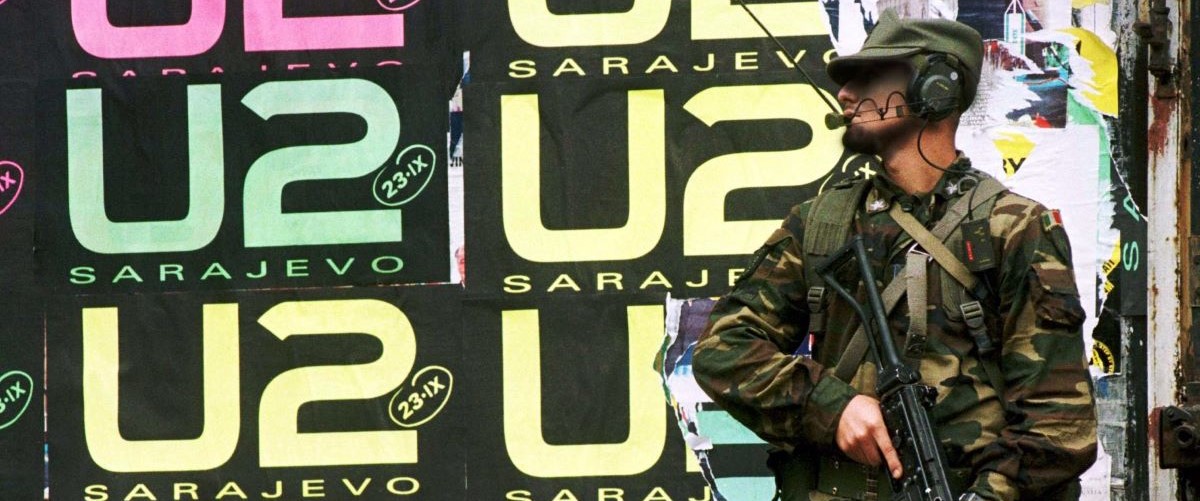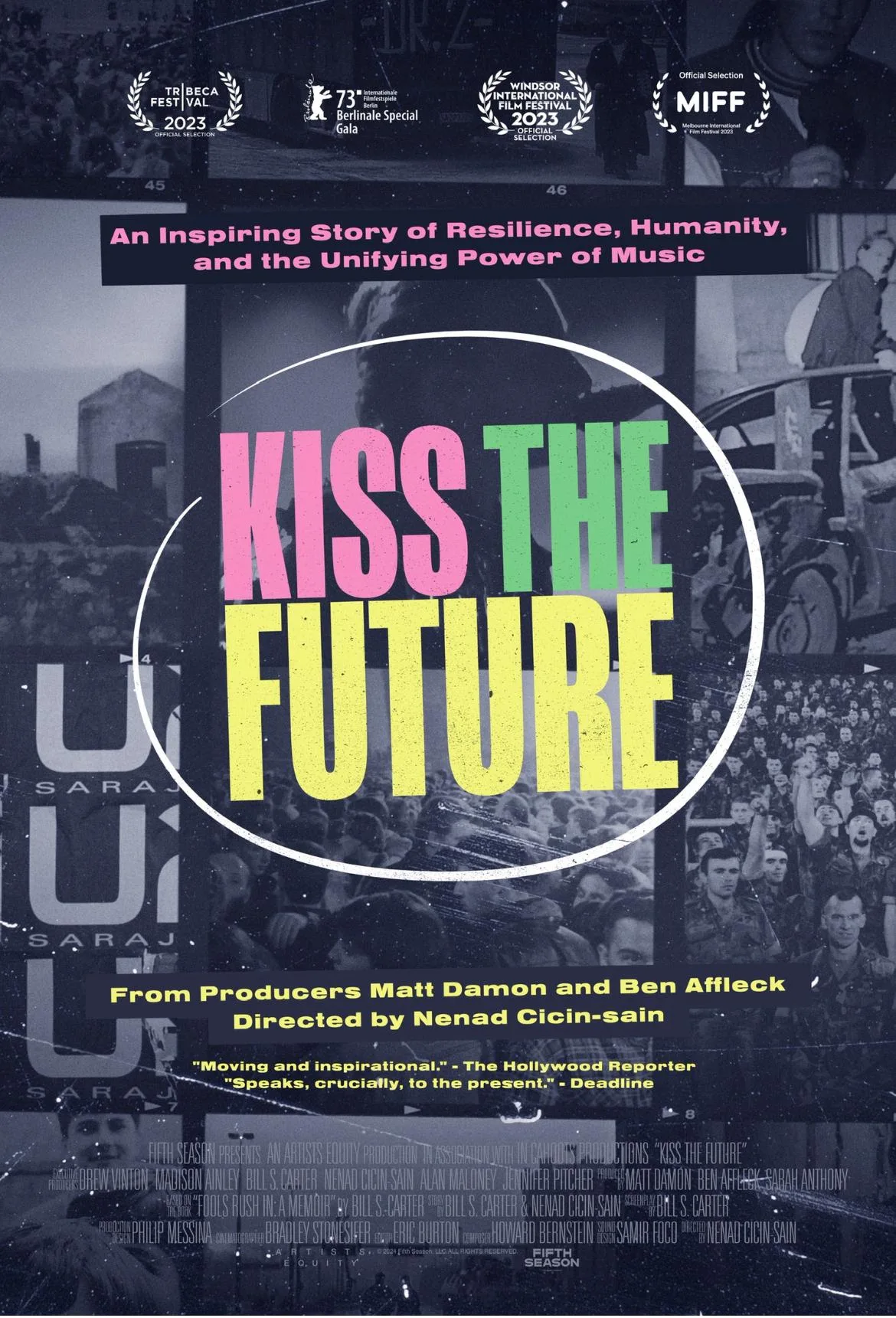There is a singular image that beautifully sums up the theme of Nenad Cicin-Sain’s “Kiss the Future” as well as the siege in Sarajevo itself. I have seen this image many times: as a CD cover, a poster, a heavily filtered image in a music video, on a giant screen in a stadium during a rock show and, finally, as raw footage. The image is that of a beauty pageant in a room that looks like a small dance hall. Nothing spectacular. About ten women, all clad in one-piece bathing suits. All tall, slender, smiling, beautiful. They do some runway walks. We get treated to close-ups of their radiant smiles. It all looks so innocent and harmless, just like any other low-budget beauty pageant. Then, and this is the singular image, they all help unfold a banner. It takes about thirty seconds to finally get it all unrolled and straightened out. The sign reads, with all the contestants standing behind it, in big, bold letters: DON’T LET THEM KILL US.
Above this basement dwelling in Sarajevo, citizens lived under siege of their own president, Slobodan Milošević, who used nationalist policies and ethnic cleansing as a way of driving out and massacring the diverse population of this peaceful city. The people had little means to fight back with actual weaponry, but they had a kind of resilience about them that had more to do with spirit than brawn. They were artists, humorists, punk rock bands, fans and, of course, beauty pageant contestants. “Kiss the Future” tells their story of how the people of Sarajevo used art as a means of survival and normalcy at night while dodging sniper fire from the Serbian army during the day.
Cicin-Sain’s film sets the table for what might be another standard documentary about an atrocity from decades ago, one in which survivors recount one horrific story after another. Of course, war is hell. What a shame it would have been if the film maintained that usual course for 103 minutes instead of focusing on the people and culture of Sarajevo itself during this time. One of the first people we learn about is Enes Zlatar, the lead singer of punk band Sikter, who found himself volunteering for the fire department with no experience at all. Zlatar is full of smiles and wit. Amidst all the chaos, violence and constant gunfire in the streets — which became unrecognizable piles of hollowed out buildings, cars and decay — he found people need some semblance of normalcy. He and his bandmates decided to start playing shows in underground discos, powered by generators. Other artists followed his lead, and, soon, an underground art and punk movement took place, often covered by a local media station called RAT ART.
The siege itself is hardly noticed by the mainstream media, apart from Christiane Amanpour doing some solid boots-on-the-ground coverage. It’s 1992-93 and the UN has barely noticed the atrocities taking place. They have grown accustomed to turning a blind eye to everything in Bosnia and Herzegovina. An independent journalist named Bill Carter (co-producer of this film) has been documenting all of this with his camera. He got it in his head to try and land an interview with his favorite band, U2, who happened to be on tour with the groundbreaking Zoo TV tour in Europe at this time, where they would beam in live television via satellite during their concerts. In one of the film’s funnier stories (yes, there are laughs in this), Carter recounts the circuitous way he finally landed a backstage interview with Bono, where he wanted to tell him about the situation in Sarajevo, but more importantly, the people and the culture. It’s all news to Bono and he appears genuinely intrigued about going there.
From there, Cicin-Sain makes U2 a central focus for a few stretches of the film, and rightfully so. After all, the band landed on the front page of every newspaper in every city they visited while on tour. So, they decided to use that coverage to bring more attention to the war-torn streets of Sarajevo by doing live interviews with its citizens during their show. Carter hosted the interviews, many of whom tell their stories in this film, while Bono would talk to them in front of thousands of fans. Finally, because of this gesture, people in the media grew more aware. But Cicin-Sain doesn’t hold U2 up too high on the pedestal for this. Everyone in the U2 camp agreed on the flaw in this design: it really didn’t rouse people to enact change. One interview, in particular, brought a U2 show to a screeching halt, as a woman asked Bono, “What are you really doing for us? I think nothing.” “The Greatest Night in Pop” might play a little differently after watching this.
Many years later, though, U2 fulfilled their promise to play a show in Sarajevo as part of their PopMart Tour in 1997-98, a show which serves as a climax for the film and the symbolic end to the war for many. U2’s fans (myself included) will make up a large chunk of the audience for this film, but Cicin-Sain knows that the bigger story here is how not just art, but normalcy and joy, can be used to combat those in power who seek to destroy and oppress. Nobody’s music or art or humor helped end the war or stop bullets from flying, but to be a participant or audience member at any show or beauty pageant of any kind felt like enough of an F.U. to everyone in power. Sometimes that’s enough.
To U2’s credit, they insisted this film not be about them, but about the people of Sarajevo. Cicin-Sain does his best to maintain that balance, but the emotional payoff at the end might resonate with fans more than the casual viewer. “Kiss The Future” doesn’t take any stylistic risks and doesn’t add anything new to the documentary form. It’s pretty straightforward in its approach and we know there will be a “how this is relevant today” message by the film’s end. Luckily, Cicin-Sain keeps the obvious parallels to a minimum during the film’s closing so that we are not left with just anger, fear and crippling hopelessness as we look ahead to the 2024 election year and all the international strife currently unfolding. “Kiss The Future” uses hope, joy and love of art as its foundation for building its thesis on how the arts unifies, how it scares people in power and how it helped rebuild a city you’ll want to visit after seeing this film. The “DON’T LET THEM KILL US” sign is not just a plea to the rest of the world outside Sarajevo, but to the citizens themselves.
Opens on February 23rd with some special screenings February 21st in some markets.




















